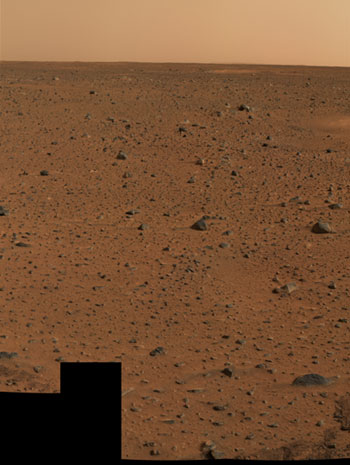Geotimes

Web Extra Tuesday,
January 6, 2004
Editor's note: A shorter version of this article
appeared in the February print issue of Geotimes.
Mars geologist in action
 After
a successful landing close to midnight EST last Saturday, the Mars exploration
rover Spirit has been sending back information to its human tenders, in Pasadena,
Calif. After three hours, Spirit took the first panorama view of its new home
in the Gusev crater. The following day, Spirit sent back the highest resolution
image ever taken of another planet.
After
a successful landing close to midnight EST last Saturday, the Mars exploration
rover Spirit has been sending back information to its human tenders, in Pasadena,
Calif. After three hours, Spirit took the first panorama view of its new home
in the Gusev crater. The following day, Spirit sent back the highest resolution
image ever taken of another planet.
Spirit's first high resolution image of its surroundings. Click on the image
to download a larger picture. See below for the panorama
that Spirit first sent to Earth. Images courtesy of NASA.
Earthlings have been to Mars before — via several mechanical envoys to
the Red Planet's surface. But the current robotic emissary is several times
larger than the first mobile explorer Sojourner. Spirit, which is the size of
a golf cart, and its twin Opportunity, which will land Jan. 25, are much better
equipped for some geology field work.
Tricked out with a stereo panoramic camera (which took the high-resolution
color image to the right), the rovers have a robotic arm to collect rock samples,
a rock grinder (to abrade surfaces for fresh, unweathered rock), a microscope
and three spectrometers. One of the spectrometers will view the martian landscape
in the infrared, to determine what rocks or sites might be most interesting
to investigate. The other two will examine rocks at closer range, checking for
iron-bearing minerals and using X-rays to determine more general composition.
The microscope will act as the rovers' (and their scientists') hand lens, for
inspecting grain sizes and other rock characteristics.
After waiting since last July's sendoff to watch Spirit's landing, the Mars
explorer crew of NASA scientists is now planning for the next step: unlocking
its "legs," or untucking the wheels so the robot explorer can drive
off its landing platform and head for a target. One potential visiting site
is "Sleepy Hollow," a depression an as-yet unknown distance away from
the landing site that may or may not have held water at one point.
The rest of the geoscience community will be watching Spirit and Opportunity
later this month to see what evidence they might find for life on the dry, dusty
planet. Spirit will start exploring its environs next week.
Naomi Lubick
Links:
Mars
Rover Mission Home
Athena
Web page for science from the rovers
More coverage of the exploration of Mars in Geotimes,
May 2003: "Landing
the Mars Explorers" and "Technology:
Robotic Geologists Take to Mars"
 The
image to the left is Spirit's first panorama view of where the craft landed,
in Gusev crater. Click the image for a larger, three-dimensional view.
The
image to the left is Spirit's first panorama view of where the craft landed,
in Gusev crater. Click the image for a larger, three-dimensional view.
Back to top
 After
a successful landing close to midnight EST last Saturday, the Mars exploration
rover Spirit has been sending back information to its human tenders, in Pasadena,
Calif. After three hours, Spirit took the first panorama view of its new home
in the Gusev crater. The following day, Spirit sent back the highest resolution
image ever taken of another planet.
After
a successful landing close to midnight EST last Saturday, the Mars exploration
rover Spirit has been sending back information to its human tenders, in Pasadena,
Calif. After three hours, Spirit took the first panorama view of its new home
in the Gusev crater. The following day, Spirit sent back the highest resolution
image ever taken of another planet.

